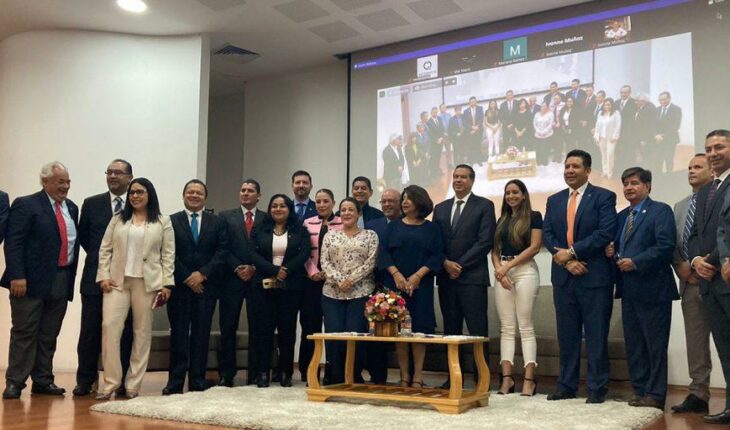Mexico was, in 2021, one of the three countries that registered the highest number of cybernetics. In just one semester, 65 million attacks were registered, so prevention and training to deal with this threat is essential.
This is how experts and authorities in the field agreed during the First Cybersecurity Forum organized by the National Chamber of the Transformation Industry (Canacintra), during which it was sought to raise awareness that citizens generally care more about the crimes that happen on the street and in everyday life, but cybercrime in Mexico and the world has become more important.
During his participation, the Undersecretary of Public Security of the Government of Mexico, Ricardo Mejía Berdeja, considered that cybercriminals take advantage of distance and anonymity, in addition to increasingly using more sophisticated tools for their cybercrimes.
“Every day we have to be more aware of this new reality and act accordingly,” he said during the opening of the event. “And this is part of the technological and civilizational development that we have had as humanity. This increased connectivity has made us more vulnerable.”
The First Cybersecurity Forum was organized by the Industrial Sector of Information Technology and Knowledge Economy (TIEC), of Canacintra and was entitled “The importance of technologies in the fight against insecurity”.
The event was also attended by Carlos Barrera, president of the TIEC Industrial Sector, and Ángel Catalán, legal attaché for Mexico of the Embassy of the United States of America, as well as Edgardo Flores, vice president of Security of the TIEC Sector; José Manuel Sánchez, National Vice President of Industrial Sectors and Branches; and Rodolfo Martínez, Vice President of Strategic Projects TIEC Sector.
Mejía Berdeja recognized that in a more connected world like the current one, risks and vulnerability increase, so it is essential to take measures to avoid these attacks.
“A national registry of cyber incidents has just been established. All the police in the country are going to develop intelligence areas to document the catalog of digital crimes, not only to combat crime, but to prevent them from being committed,” he said.
Minors at risk
Another threat from cybercriminals is that they target minors with the use of social networks and video games.
“We have detected that the use of social networks has become an instrument of harassment and criminal recruitment and corruption of minors. We have seen several cases of how through these platforms they deceive minors, and that is why they leave their home and then are reported as missing persons,” he observed.
“The risk that minors are placed in is great because many of those online ‘friends’ are criminals who pose as minors when behind them there are pedophiles, pedophiles or people who engage in child pornography. And we have also detected it in video games, minors who leave their home because they met a ‘friend’ and then are reported missing,” said Mejía Berdeja.
Prevention first and foremost
When a cyber attack happens, the result is that there is no longer much to do but the technical part that has to do with the disposal of the equipment, acknowledged Alejandro Canales, director of Cybersecurity of the Secretariat of Security and Citizen Protection of the Government of Mexico, so it is important “to have channels that help us prevent cyberattacks undoubtedly helps a lot.”
Participating in the presentation “The role of information technologies and security in Mexico,” Canales said that the recent attacks that have occurred in the cyber war between Ukraine and Russia “show us where we are going, what kind of attacks we can expect; we have to maintain communication and coordination to be able to prevent attacks of this type from materializing.”
Meanwhile, José Enrique Vallarta, general director of Penitentiary Policy and Development of the Secretariat of Security and Citizen Protection of the Government of Mexico, advised to establish a culture of prevention, which results in preventing cyberattacks from largely not achieving their objectives.
“More training is needed to be able to identify the types of crimes. There is tremendous innovation in this type of crime, there are tourist frauds, there are crimes of hacking accounts, whatsApp. That is why the instances must be strengthened and courses given to the personnel involved in cybersecurity.”
Carlos A. Tomala, a member of the U.S. Embassy and the FBI Department of Justice, said that one of the most relevant issues in the field of digital security isThe link that must be had between the government, the private sector and between nations.
“In the cyber issue there are no borders. One collaboration we have with Mexico is to join forces and share resources and training to strengthen its capabilities and refine its processes in cybercrime investigations. The neighbor must be supported because cybercrime has no borders,” Tomala said.
Cybersecurity and gender
During the forum, the presentation “The importance of the gender perspective in cybersecurity” was held, which was headed by Begoña Márquez, president of the Industrial Branch No. 23 Digital Marketing, and Monserrat Peña, deputy director of Institutional Linkage at Metabase Q.
“This is an extraordinary forum. Particularly, this conference is very important because of the gender perspective in cybersecurity,” explained Begoña Márquez. “We’ve really covered a lot of sectors and expanded them as women. We are making more and more progress on all rubles, and this forum could not be the exception.”
Meanwhile, Monserrat Peña said that, in the area of science and technology, gender biases and gaps are more current than would be expected. Among these are mainly the lack of professionalization and occupation, as well as digital violence, he explained.
“From basic education, many girls are discouraged from studying STEM disciplines, that is, related to science, technology, engineering and mathematics. This means that they occupy fewer work spaces and leadership positions in these sectors. This in turn joins all the other digital divides that impact girls and women the most: the lack of access to the internet and the scarcity of information about cybersecurity.”
The First Cybersecurity Forum was also attended by various experts who dealt with topics such as hacking, social media security, data protection, technology development and computer security.
Given that the objective of this forum is to call for reflection and generate a culture of prevention in terms of cybersecurity, the Vice President of Security of the TIEC Sector said that a megatrend is already underway in private organizations, chambers, unions, unions, schools, academies, to have security areas in their structures.
“And the issue of cybersecurity cannot be oblivious to that spectrum of considerations. Prevention represents a challenge, but almost all companies already have an area responsible for safety,” he said.
Rodrigo Alpízar, former national president of Canacintra, said that industrialists are increasingly aware that previously security was a strictly physical or material issue, but today it has a huge component in information technologies.
“Today there is a generation gap, some generations are more obsolete and we do not know the enormous implications that this issue has. Sometimes we would think: well, if my phone is stolen, I buy another one and that’s it. But no, it’s not that easy, that can seriously affect you in the long term because of all the information you have stored there.”
Prevention, the best tool against cyber attacks
May 26, 2022 |





